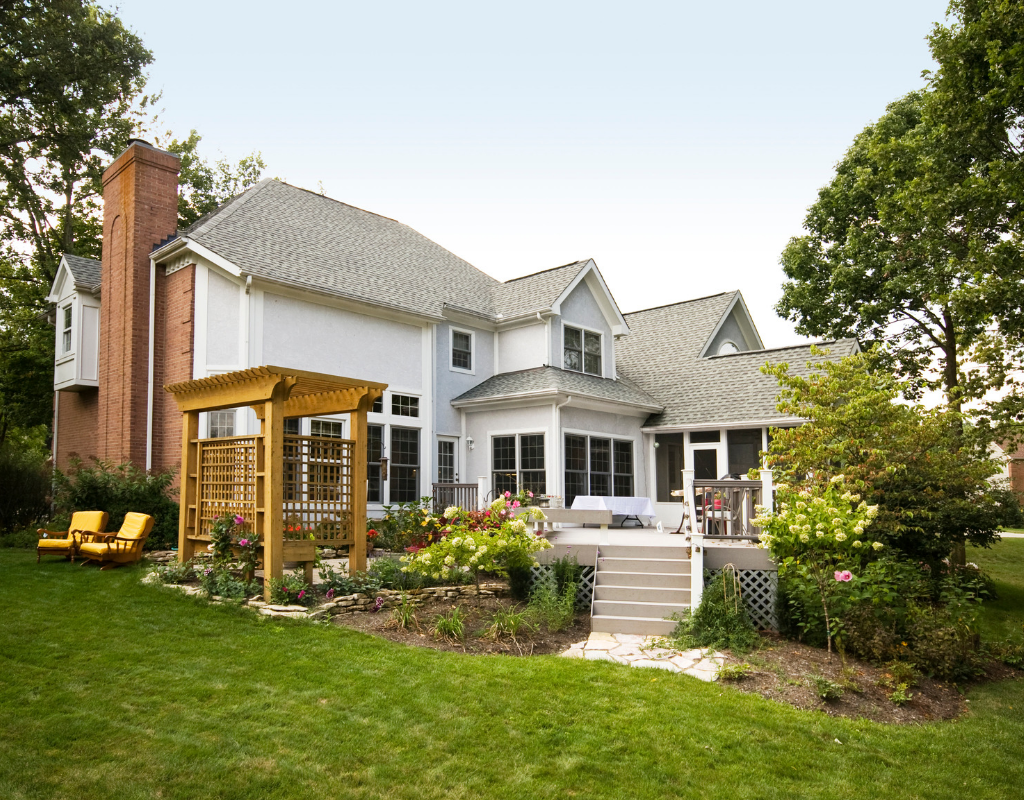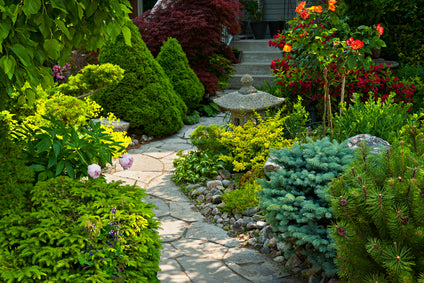
If you’re planning to do any landscaping or hardscaping around your home, it’s not just a good idea to know the dimensions and layout of your property—it’s practically essential. Knowing the size and location of existing structures and utility lines, as well as where your property begins and ends, will allow you to see how your new projects will fit in and ensure that you don’t cross any property boundaries. And in order to have this information on hand, you’ll need a landscape plan.
Drawing a landscape plan can be complicated, so if you’re embarking on a larger-scale project, like adding a swimming pool to your backyard, you’ll most likely want to hire a professional. However, if you’re working on a smaller project, like adding new flowerbeds, you may be able to draw your own functional landscape plan. Here’s what you’ll need to do.
Locate your property’s site plan.
In order to draw a landscape plan, you’re going to need to know the size and scale of your property. You can find this information on your property’s site plan, which may have come with the deed when you purchased your home. If you can’t locate your site plan, or if you believe your site plan is out of date, you’ll need to order a new one.
If you custom order a site plan, you can actually skip the next two steps and simply create your landscape plan by laying tracing paper over the site plan and sketching in the new features you want to add (drawn to scale).
Decide on a scale.
The best way to start a landscape plan is to purchase graph paper and select a scale. For example, you might say the one square on the graph paper represents one square foot of your property.
Measure your property.
If you don’t have an up-to-date site plan, you’ll need to measure the length of all your property borders, and then measure your house as well as the distance between the house and the boundaries on all sides. You’ll also need to measure any other elements on your property, such as a patio or a pathway, in relation to the house and boundaries. Use at least two fixed points of reference when measuring all elements in order to get a more accurate plan. Once you’ve recorded all your measurements, you’ll be able to draw all the features to scale on your graph paper.
Add bubble diagrams.
Once you have your initial landscape plan, whether it’s the one you drew on graph paper or the site plan you ordered, lay your graph paper over the top and add “bubble diagrams”. This involves drawing circles or ovals in any currently free space on your property and designating it for a certain purpose, such as “gazebo” or “planting bed”. Make sure you leave some space to navigate between these bubbles—you don’t want your yard to be too crowded!
Use your bubble diagrams to determine the space available for your landscaping projects.
Keeping the scale of your plan in mind, work out how many square feet you’ll need for each feature that you plan on adding. Again, if you’re planning to add larger features, it’s advisable to work with a professional landscaper.
Save yourself several steps in the landscape planning process by ordering a professional site plan from MySitePlan. We’ll provide you with an up-to-date and detailed plot plan in two working days or less.
All You Need to Know about Using a Plot Plan for Landscaping
Are you a weekend weed-eating warrior? A backyard garden guru? How about a professional landscaper still committing client plans to memory?
On the one hand, realizing a landscaping vision can seem a lot more time-consuming or difficult than the kind of project you can realistically commit to. Still, if you’re reading this article, you have to admit the lure of a lush green outdoor retreat likely has you toiling away regardless of the effort it takes this season... and on into the next.
On the other hand, perhaps you’ve made a life of landscaping. And your client list has become longer than the hours you have in a day. In this case, building your business means finding ways to work smarter — not harder. You may simply not be sure how to reclaim more of your time for continued net-positive growth.
In either case, a plot plan for your landscaping project may be exactly what you need. For those who don’t know, a plot plan is synonymous with a site plan, a sort of map of the exterior areas of a home.
Because plot plans are now so much more readily available - not to mention extremely cost-effective - those with a passion for creating beautiful outdoor spaces are more and more often turning to this easy-to-use planning solution to plot, design, and realize their (or their clients’) oasis dreams.
Related: Site Plan: Everything you need to know in 2019.
Why Do You Need A Plot Plan?

Unless you have no more than a postage stamp to maintain, a plot plan will simplify your landscaping scheme.
You likely know that projects of scale require some forethought. You need to know your property size and lines and where utilities lie before you start digging. You must have exact locations of existing flora and building structures to plan around them — or decide to take them out.
All of these things can be recorded and referred to in a single plot plan, which can make buying materials and getting the proper authorization to create your ‘scape less costly, while also saving you bundles of time. Let’s take a look at how...
Plot Plans Provide an Accurate, Scaled View of Your Property
Using an online site plan service like MySitePlan takes care of accurate scaling and perfect drawing, leaving the exciting stuff to you. Explain exactly what you need to be included in your plot plan, and you’ll be provided with an easier view of what works and what doesn’t. If you need changes, just mark the revisions you need and send it back.
The final output will be exactly what you need to confidently proceed on your landscaping project!
Related: MySitePlan.com: A Quickstart Guide to Your Custom Site Plan.
This Quality Plan Is Accepted by Your Municipality
Most municipalities have some requirements for landscape project permitting. Generally, they relate to certain structural dimensions (like retaining walls or decking) and their effects on water retention and run-off. While permits can take months to secure, providing professional-quality plot plans that note all prerequisites can ensure swift processing and approval.
What’s more, you can even put a stop to encroaching neighbor projects by presenting your plan as evidence for an official complaint to the city.
Collaborating with Clients or Other Professionals Has Never Been Easier
Finally, when you run into a snag with your personal landscaping plan, or as a landscaper need to share a client’s ongoing vision with collaborative partners, you have your plot plan on hand. With a quick print, you can ensure everyone involved is on the same page.
MySitePlan currently offers three different types of plans at a fraction of the cost you would pay for the average land surveyor. Whether you’re planning a combination of raised beds and swales to grow your own food, creating a resort-style backyard retreat, or dealing with a neighbor’s fence posts on your side of the line, MySitePlan can help you quickly and professionally resolve the issue.
Determine Your Goals for the Landscape Project

First, you should know why you are making these changes. A few examples of reasons people undertake landscaping projects include:
- To increase the value of their property.
- To create a play area for their children.
- To get protection from the wind or sun.
- To create an area for entertaining guests.
- To gain privacy from neighbors or streets.
You may actually have several goals for the project. If so, you should prioritize them. What’s most important to you? What’s least important?
Another goal that is key to determine upfront is your budget. What is the range you need to stay within? Over what period of time can you invest that money? If you have to make any sacrifices to stay within budget, remembering why you embarked on this project will help you make those decisions.
How to Create Your Initial Plot Plan

Developing your landscaping ideas used to require measuring each area of your property by pulling up your bootstraps and pulling out the measuring tape. Then you would record your measurements to incorporate them into your hand-drawn site plan.
Once all the measurements were taken (and retaken, because you should always “measure twice”), it was time to decide on the scale - one square box could equal one square foot, for instance. After that, you could finally begin blueprinting all the gathered info onto your graph paper pad.
This process takes so much more time than simply hiring a professional. And landscapers doing everything by hand are always at greater risk of encountering inaccuracies due to simple human error at execution time. These errors can cost both time and money.
Alternatively, you could purchase a plotting program. But the learning curve is often steep and time-consuming.
Instead, try the third option: hire a service that will professionally create the plot plan for you. The right site plan service will ultimately depend on your goals and needs.
You can either hire a surveyor to come out and measure your property for hundreds of dollars. Or you can utilize an online service that uses online data sources to draw up a plan. These services never even have to send anyone out to your home in order to accurately draw up the base-line blueprint of the area you intend to landscape.
At MySitePlan, we combine satellite imaging with GIS information, county parcel maps, and other public data to deliver our detailed site plans. If you have a survey or any sketches or ground measurements that you would like to include, we can certainly use those, too.
Our quickstart guide shares the basic steps for getting the process underway. The initial plan will always incorporate the following elements at minimum:
- Your home structure
- Property boundary lines
- Existing plants and fixed outdoor structures
- Outdoor utilities
- Existing irrigation systems
- Slopes/drainage areas
This layout becomes the base visual for realizing your (or your client’s) fully-developed landscaping plan. From here you can begin the creative work of determining what to keep and where changes or new additions should be made.
After that, you can annotate the additions you need to be included in the drawing, and one of our professional AutoCAD designers will add them to the plot plan. If you need any changes, you can simply note them and request revisions. When they are done, you will have a plot plan that accurately represents your ideas for that backyard oasis.
Related: How Site Plan Rendering Can Help You Convey a Breathtaking Property Design.
When to Hire MySitePlan to Create Your Plot Plan

Here are a few of the most common reasons our clients opt to use MySitePlan instead of utilizing other options for their site plans.
When You Want to Save Your Budget for the Actual Work
Hiring a landscape design firm or landscape architect is sometimes necessary -- when you have specific architectural home features that you are trying to align your design with or you have true engineering challenges to meet, like building retaining walls because you live on a cliff.
Otherwise, save yourself hundreds (sometimes even thousands of dollars!) when working through the initial planning and revisions by ordering a professional site plan from us.
When You Want a Little Technical Help
AutoCAD and other programs that produce accurate site plans take a significant investment of time to learn. Even if you have a basic proficiency, it may take you hours of work to create the site plan.
MySitePlan is a company full of AutoCAD designers who’ve had a lot of designs pass through their hands. We’ve worked on projects big and small. And we know AutoCAD inside and out. The end result is a professional plot plan — with more time for you to focus on making the project happen.
When You’d Rather Be in the Garden
You provide the details, and we’ll provide you with an initial blueprint plan in as little as 24 hours. If you need revisions, just make notes, and we’ll get a revised plan to you.
That way, you spend less time on the computer — and more time doing what you love in the garden!
Related: Best Plants for Paths and Patio Edges.
When You Don’t Need a Stamp or Seal Included
Although MySitePlan site plans do not come with a surveyor, architect, or engineer’s seal or stamp, our Auto CAD designers provide the deliverables you need in order to best explain your vision to these and other landscaping professionals.
They are also the plans you present for the permits required by your neighborhood and municipal development in situations where a certified plan isn’t required. This is often the case for landscaping projects.
At MySitePlan, we guarantee that your local building department will accept our plans as long as a stamp from a surveyor, architect, or engineer is not required. Our plans have been used to gain permits in cities and counties across the country.
Getting Creative with Your Diagrams
When creating a landscaping plan with MySitePlan, you can include details about the dimensions of features you want to be added, and where exactly they should be located. Or you can sketch them in after you receive a draft containing a plot plan for the existing structures and features.
You can quickly navigate through our services, pricing, and quote request pages from the menu bar on our MySitePlan home page. And our Help Center is great because even when your particular question isn’t listed on the FAQ section, there’s an in-site search bar where you can type your exact inquiry.
And we are always transparent about all of our options, so you never have to wonder whether a given feature might “cost extra.” Check out what landscapers like yourself are saying in our reviews section.
How the Process Works at MySitePlan

Using the MySitePlan Detailed Site Plan option as an example, during the basic process of plot planning, you’ve submitted everything you have, and the team has sent back a plot plan as the location looks know.
At this point, you can sketch in any required updates. This can include dimension corrections or missing items due to tree cover. And it can also include the landscaping items you envision for the project.
We have an extensive list of topographical, structural, and plantlife graphics that can be customized to scale for your planning. Simply add in what you need under the proper drop-down menu, and when you don’t see what you’re looking for, we’re here to guide you.
You send the revisions back to us to have the updates made. Once that happens, we’ll send you back your final plan, and you’ll be ready to get working.
If you require changes later in the project, it is still possible to reach out for further revisions. Your digital plans are archived for a specific period of time within our files.
Otherwise, you can always re-submit your current version as a base for the next phase you’d like to work on. Many begin by moving the earth around and getting base structures in.
Below is a sample of how someone might choose to move forward with their plot planning for their long-term landscaping goals for an entire property.
PHASE 1: Current Footprint
This is the digital file created through one of the three plot-planning options, all current structures, and existing landscape layout.
There is an option that appears after entering your address to “Add Topographical Lines.” Topographical updates can be made at the normal 2-5 foot intervals.
PHASE 2: Adding New Features
When placing your order, you’ll notice an option to “Add Non-Existing Feature”. You can select the number of non-existing features you need to be added here. Alternatively, you can ask for a custom quote for your specific project.
Again, you can specify what you need to be added right away in your initial instructions. But many prefer to sketch in the items after receiving the initial plot plan back. This is where you draw in your big vision for the project.
Perhaps you’d like to get the raised food garden beds in first so that you can cultivate your own food. Maybe you’d really like a section of native pollinators nearby shortly after. A water feature before the summer heat sets in? And of course, you need your wandering paths set before winter.
Whatever order best suits your landscaping dreams, you can break them up into as many new layers of planning as you please.
Although this list is in no way exhaustive, some of the most common additions we see include:
- Barns
- Sheds
- Fences
- Pergolas
- Patio covers
- Patios
- Paths
- Driveways
- Shrubs
- Lawns
- Trees
-
Water features
For each feature, you will have the option to either describe the dimensions of your newest feature and where you’d like it to be placed or simply sketch it onto a copy of your most recent draft. We will always work with you to ensure perfect placement.
Using Bubble Diagrams for Your Landscape Plot Plan

Bubble diagrams can be an effective way to see how your landscape ideas may fit in the space after you have the initial plot plan created.
Here is how it works:
- Lay graph paper over the plan.
- Draw circles or ovals (the “bubbles”) over free space on the property.
- Label these bubbles with what you envision filing them (e.g., gazebo, planting bed).
- Make sure there is ample space to navigate around and between bubbles.
- Adjust them accordingly to ensure your backyard has enough space.
- Measure the bubbles to see how much square footage will be taken up by each item.
- Use this information to order materials for your project accordingly.
Using a plot plan for landscaping can be an incredibly creative and rewarding experience. Choosing MySitePlan will help bring an element of professionalism to your landscaping discussion - whether you’re the landscaper or a client sitting down to discuss your dreams.
Our level of customer service - at a price point that makes sense - is unmatched. And the best part about it, we love what we do: helping folks like you put the foresight into making your landscaping projects a reality.
How to Create a Landscape Plan

The beautiful landscapes you see in home and garden magazines are attainable, but they don’t just occur by chance. Landscapers don’t just add trees, plants, and walkways at random; they carefully plan everything to make sure that they get the most out of the space they’re working with.
If you’ve been dreaming of making big changes to your backyard, the first thing you need to do is create a landscape plan. This plan should include:
- Your house
- Property boundaries
- Existing plants and outdoor structures, such as a pool or patio
- Outdoor utilities
- Existing irrigation systems
- Slopes/drainage areas
Your landscape plan will provide a great visual tool to determine where your new additions will lie in relation to existing structures. By carefully sketching out your landscaping ideas on your plan, you can ensure that you combine form and function in the best possible way for your home. Here are a few things to do to create a landscape plan that works for your project.
Determine the goal of your project. Are you hoping to add value to your home? Wanting to create a play area for your kids? Interested in adding trees to create a wind break? In many cases, you’ll probably have multiple goals for your landscaping project. By sitting down and articulating what you actually want to do, you’ll be able to start figuring out what changes to make.
Order a detailed site plan. Drawing your own landscape plan can be tricky and time-consuming—plus there’s a lot of room for error. In order to expedite the process and ensure that the plan is accurate, order a detailed plan that includes the landscape, trees, swimming pools, driveways, structures, and pathways. MySitePlan creates this type of plan using satellite imagery in combination with county parcel maps, allowing them to get your landscape plan to you within 2-3 business days.
Use tracing paper to sketch out ideas. Rather than drawing directly on your site plan, use tracing paper that you can place over the plan to sketch out the changes you’re interested in making. You may want to sketch out several different versions and allow your family to draw their own versions in order to do a comparison.
Keep logistics in mind. Before you finalize your landscaping plan, go over some of the logistics. For example, a willow tree that you plant now is going to be significantly larger in 20 years—is your yard large enough? If you’re adding a structure like a swimming pool, do you have the required permits to start construction? If your landscaping project does require construction, you’ll need to take a clean copy of your site plan to your city government to get a building permit.
Landscaping can be an incredibly rewarding experience… as long as you take the time to plan everything out ahead of time. Make sure that you’ve put some thought into your project and looked closely at your landscape plan so that you don’t have any unpleasant surprises when you start making changes.
| FAQ |
Answer |
| What is the best season to start a landscaping project? |
The best season typically depends on the climate and the type of plants. Spring and autumn are usually the most favorable due to cooler weather and more manageable soil. |
| How can I ensure that my landscaping plan aligns with local zoning laws and regulations? |
Contact your local planning or building department for specific guidelines before beginning your project. This helps ensure compliance and avoid legal issues. |
| Can landscaping improve energy efficiency in my home? |
Yes, strategic landscaping can improve energy efficiency. For example, trees providing shade can reduce cooling costs in summer, and evergreens can act as windbreaks to lower heating costs in winter. |
| What are the considerations for choosing plants based on my local climate? |
Consider local climate zones, soil type, sun exposure, and water availability. Native plants are often best as they require less maintenance and adapt well to local conditions. |
| How often should I update my landscape plan? |
It's advisable to review and update your landscape plan every 3 to 5 years to adjust for changes in property usage, plant growth, and personal preferences. |
| What are the benefits of using professional landscaping services over DIY projects? |
Professionals offer expert design, plant selection, and installation. They can handle complex projects efficiently and deal with unexpected issues, potentially saving time and money. |
| How can I incorporate sustainable practices into my landscaping project? |
Use native plants, install rain gardens, use organic mulches, and implement drip irrigation systems. Choose permeable materials for pathways and driveways to manage water runoff. |








